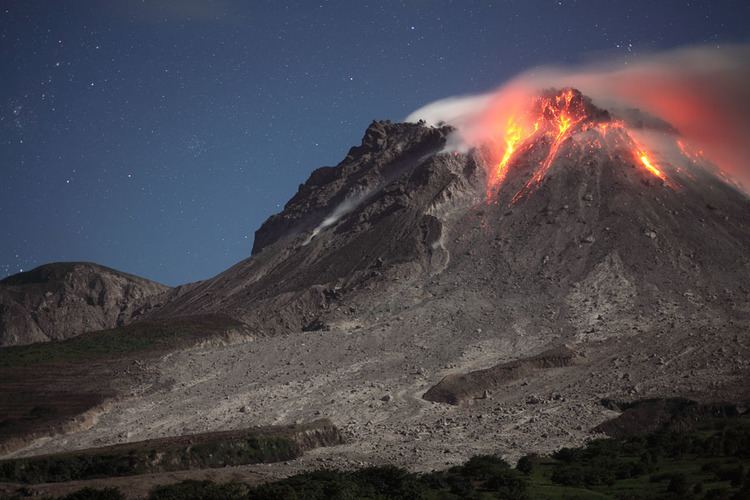Last eruption 2012 Prominence 915 m | Elevation 915 m | |
 | ||
Similar La Soufrière, Mount Pelée, Chances Peak, La Grande Soufrière, Santa María | ||
Montserrat eruption 11 02 10 soufri re hills
The Soufrière Hills volcano is an active, complex stratovolcano with many lava domes forming its summit, on the Caribbean island of Montserrat. Many volcanoes in the Caribbean are named Soufrière (French: "sulphur outlet"). These include La Soufrière or Soufrière Saint Vincent on the island of Saint Vincent and La Grande Soufrière on Guadeloupe. After a long period of dormancy, the Soufrière Hills volcano became active in 1995, and has continued to erupt ever since. Its eruptions have rendered more than half of Montserrat uninhabitable, destroying the capital city, Plymouth, and causing widespread evacuations: about two thirds of the population have left the island.
Contents
- Montserrat eruption 11 02 10 soufri re hills
- Map of SoufriC3A8re Hills Montserrat
- Early history
- 19951999 eruption
- Destroyed settlements
- Abandoned settlements
- Activity since 1999
- In popular culture
- References
Map of Soufri%C3%A8re Hills, Montserrat
It is andesitic in nature and the current pattern of activity includes periods of lava dome growth, punctuated by brief episodes of dome collapse which result in pyroclastic flows, ash venting, and explosive eruption. The volcano is monitored by the Montserrat Volcano Observatory. Volcanic gas emissions from this volcano are measured by a Multi-Component Gas Analyzer System, which detects pre-eruptive degassing of rising magmas, improving prediction of volcanic activity.
Early history
1995–1999 eruption
Seismic activity had occurred in 1897–1898, 1933–1937, and again in 1966–1967, but the eruption that began on 18 July 1995 was the first since the 19th century in Montserrat. When pyroclastic flows and mudflows began occurring regularly, the capital, Plymouth, was evacuated, and a few weeks later a pyroclastic flow covered the city in several metres of debris.
The first phreatic explosion in this new period of activity occurred on 21 August 1995, and such activity lasted for 18 weeks until it caused an andesitic lava dome formation. This was initially confined by a sector-collapse scar. This period lasted for another 60 weeks, after which there were major dome collapses and two periods of explosive volcanic eruptions and fountain-collapse pyroclastic flows. The explosion blanketed Plymouth, 6 kilometres (3.7 mi) away, in a thick layer of ash, and darkened the sky almost completely.
Earthquakes continued to occur in three epicenter zones: beneath the Soufrière Hills volcano, in the ridge running to the north-east, and beneath St George's Hill, about 5 kilometres (3.1 mi) to the north-west. A large eruption on 25 June 1997 resulted in the deaths of nineteen people. The island's airport was directly in the path of the main pyroclastic flow and was completely destroyed. Montserrat's tourist industry was also destroyed, although it began to recover within fifteen years.
The governments of the United Kingdom and Montserrat led the aid effort, including a £41 million package provided to the people of Montserrat; however, riots followed as the people protested that the British Government was not doing enough to aid relief. The riots followed a £10 million aid offer by International Development Secretary Clare Short, prompting the resignation of Bertrand Osborne, then Chief Minister of Montserrat after allegations of being too pro-British and not demanding a better offer.
The British destroyer HMS Liverpool took a large role in evacuating Montserrat's population to other islands; this included Antigua and Barbuda, who warned they would not be able to cope with many more refugees. About 7,000 people, or two-thirds of the population, left Montserrat; 4,000 to the United Kingdom.
Destroyed settlements
The following is a list of Montserrat settlements destroyed by the eruption of the Soufrière Hills volcano:
Abandoned settlements
The following is a list of Montserrat settlements abandoned after the eruption of the Soufrière Hills volcano. Most of these settlements were badly affected or inundated by pyroclastic flows between June and December 1997.
Activity since 1999
On 24 December 2006, streaks of red from the pyroclastic flows became visible. On 8 January 2007, an evacuation order was issued for areas in the Lower Belham Valley, affecting an additional 100 people.
At 11:27 pm local time on Monday 28 July 2008, an eruption began without any precursory activity. Pyroclastic flow lobes reached Plymouth. These involved juvenile material originating in the collapse of the eruption column. Further, a small part of the eastern side of the lava dome collapsed, generating a pyroclastic flow in Tar River Valley. Several large explosions were registered, with the largest at approximately 11:38 pm. The height of the ash column was estimated at 12,000 m (40,000 ft) above sea level.
The volcano has become one of the most closely monitored volcanoes in the world since its eruption began, with the Montserrat Volcano Observatory taking detailed measurements and reporting on its activity to the government and population of Montserrat. The observatory is operated by the British Geological Survey under contract to the government of Montserrat.
The 9 October 2008 issue of the journal Science suggests that two interconnected magma chambers lie beneath the surface of the volcano on Montserrat – one six kilometres below the surface and the other at 12 kilometres below the surface. They also show a link between surface behaviour and the size of the deeper magma chamber.
On 5 February 2010, a vulcanian explosion simultaneously propelled pyroclastic flows down several sides of the mountain, and on 11 February 2010, a partial collapse of the lava dome sent large ash clouds over sections of several nearby islands including Guadeloupe and Antigua. Inhabited areas of Montserrat itself received very little ash accumulation through either event.
In popular culture
Soufrière Hills is the subject of the Jimmy Buffett song "Volcano". Ian Anderson sings about this volcano in his song "Montserrat" from the The Secret Language of Birds album.
